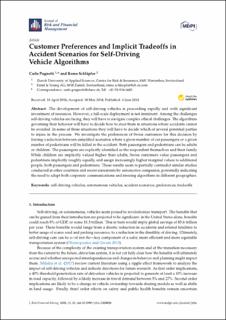Bitte benutzen Sie diese Kennung, um auf die Ressource zu verweisen:
https://doi.org/10.21256/zhaw-4719| Publikationstyp: | Beitrag in wissenschaftlicher Zeitschrift |
| Art der Begutachtung: | Peer review (Publikation) |
| Titel: | Customer preferences and implicit tradeoffs in accident scenarios for self-driving vehicle algorithms |
| Autor/-in: | Pugnetti, Carlo Schläpfer, Remo |
| DOI: | 10.21256/zhaw-4719 10.3390/jrfm11020028 |
| Erschienen in: | Journal of Risk and Financial Management |
| Band(Heft): | 11 |
| Heft: | 2 |
| Seite(n): | 28 |
| Seiten bis: | 41 |
| Erscheinungsdatum: | 2018 |
| Verlag / Hrsg. Institution: | MDPI |
| ISSN: | 1911-8066 1911-8074 |
| Sprache: | Englisch |
| Schlagwörter: | Self-driving vehicle; Autonomous vehicle; Accident scenarios |
| Fachgebiet (DDC): | 620: Ingenieurwesen |
| Zusammenfassung: | The development of self-driving vehicles is proceeding rapidly and with significant investment of resources. However, a full-scale deployment is not imminent. Among the challenges self-driving vehicles are facing, they will have to navigate complex ethical challenges. The algorithms governing their behavior will have to decide how to steer them in situations where accidents cannot be avoided. In some of these situations they will have to decide which of several potential parties to injure in the process. We investigate the preferences of Swiss customers for this decision by forcing a selection between simplified scenarios where a given number of car passengers or a given number of pedestrians will be killed in the accident. Both passengers and pedestrians can be adults or children. The passengers are explicitly identified as the respondent themselves and their family. While children are implicitly valued higher than adults, Swiss customers value passengers and pedestrians implicitly roughly equally, and assign increasingly higher marginal values to additional people, both passengers and pedestrians. These results seem to partially contradict similar studies conducted in other countries and recent statements by automotive companies, potentially indicating the need to adapt both corporate communications and steering algorithms in different geographies. |
| URI: | https://digitalcollection.zhaw.ch/handle/11475/11155 |
| Volltext Version: | Publizierte Version |
| Lizenz (gemäss Verlagsvertrag): | CC BY 4.0: Namensnennung 4.0 International |
| Departement: | School of Management and Law |
| Organisationseinheit: | Institut für Risk & Insurance (IRI) |
| Enthalten in den Sammlungen: | Publikationen School of Management and Law |
Dateien zu dieser Ressource:
| Datei | Beschreibung | Größe | Format | |
|---|---|---|---|---|
| jrfm-11-00028-1.pdf | 899.16 kB | Adobe PDF |  Öffnen/Anzeigen |
Zur Langanzeige
Pugnetti, C., & Schläpfer, R. (2018). Customer preferences and implicit tradeoffs in accident scenarios for self-driving vehicle algorithms. Journal of Risk and Financial Management, 11(2), 28–41. https://doi.org/10.21256/zhaw-4719
Pugnetti, C. and Schläpfer, R. (2018) ‘Customer preferences and implicit tradeoffs in accident scenarios for self-driving vehicle algorithms’, Journal of Risk and Financial Management, 11(2), pp. 28–41. Available at: https://doi.org/10.21256/zhaw-4719.
C. Pugnetti and R. Schläpfer, “Customer preferences and implicit tradeoffs in accident scenarios for self-driving vehicle algorithms,” Journal of Risk and Financial Management, vol. 11, no. 2, pp. 28–41, 2018, doi: 10.21256/zhaw-4719.
PUGNETTI, Carlo und Remo SCHLÄPFER, 2018. Customer preferences and implicit tradeoffs in accident scenarios for self-driving vehicle algorithms. Journal of Risk and Financial Management. 2018. Bd. 11, Nr. 2, S. 28–41. DOI 10.21256/zhaw-4719
Pugnetti, Carlo, and Remo Schläpfer. 2018. “Customer Preferences and Implicit Tradeoffs in Accident Scenarios for Self-Driving Vehicle Algorithms.” Journal of Risk and Financial Management 11 (2): 28–41. https://doi.org/10.21256/zhaw-4719.
Pugnetti, Carlo, and Remo Schläpfer. “Customer Preferences and Implicit Tradeoffs in Accident Scenarios for Self-Driving Vehicle Algorithms.” Journal of Risk and Financial Management, vol. 11, no. 2, 2018, pp. 28–41, https://doi.org/10.21256/zhaw-4719.
Alle Ressourcen in diesem Repository sind urheberrechtlich geschützt, soweit nicht anderweitig angezeigt.